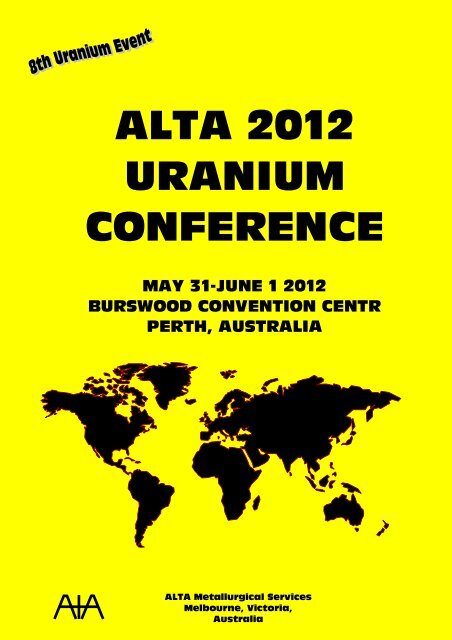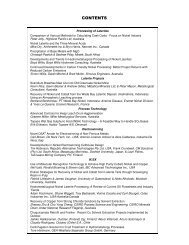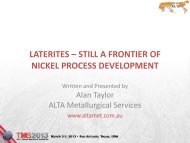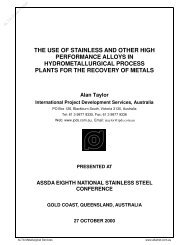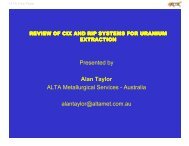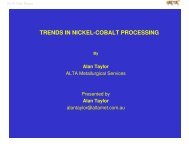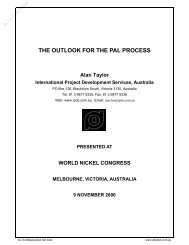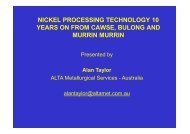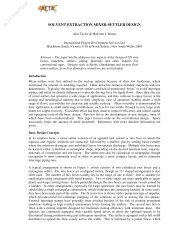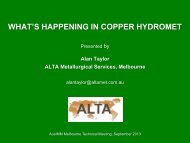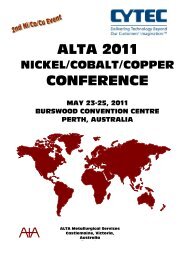Contents & Abstracts - ALTA Metallurgical Services
Contents & Abstracts - ALTA Metallurgical Services
Contents & Abstracts - ALTA Metallurgical Services
Create successful ePaper yourself
Turn your PDF publications into a flip-book with our unique Google optimized e-Paper software.
<strong>ALTA</strong> 2012<br />
URANIUM<br />
CONFERENCE<br />
MAY 31-JUNE 1 2012<br />
BURSWOOD CONVENTION CENTR<br />
PERTH, AUSTRALIA<br />
<strong>ALTA</strong> <strong>Metallurgical</strong> <strong>Services</strong><br />
Melbourne, Victoria,<br />
Australia
PROCEEDINGS OF<br />
URANIUM SESSIONS AT <strong>ALTA</strong> 2012<br />
MAY 31-June 1, 2012, PERTH, AUSTRALIA<br />
A Publication of<br />
<strong>ALTA</strong> <strong>Metallurgical</strong> <strong>Services</strong><br />
PO Box 68, Flinders Lane, Melbourne,<br />
Victoria 8009, Australia<br />
http://www.altamet.com.au<br />
ISBN: 978-0-9871262-4-5<br />
All rights reserved<br />
This publication may not be reproduced in whole or in part<br />
stored in a retrieval system or transmitted in any form or by any means<br />
without permission from the publisher<br />
The content of the papers is the sole responsibility of the authors<br />
To purchase a copy of this or other publications visit<br />
http://www.altamet.com.au/publications.htm
CONTENTS<br />
SX/IX<br />
Comparison of Various Reagents for Stripping Uranium-Loaded Alamine 336<br />
M. H. Kotze, A. C. du Preez & C. Mokwana, Mintek, South Africa<br />
Solvent Extraction of Uranium and Its Separation from Vanadium In Alkaline Solutions<br />
Zhaowu Zhu, Yoko Pranolo & Chu Yong Cheng, The Parker Centre / CSIRO Process Science<br />
and Engineering / CSIRO Minerals Down Under National Research Flagship, Australia<br />
Development of the Metrix TM Resin in Pulp System for Extracting Uranium from Hypersaline<br />
Acidic Solutions<br />
Derrin Auerswald, Bateman Engineering Projects; Marthie Kotze & Volha Yahorava, Mintek,<br />
South Africa<br />
Strong Acid Versus Ammonia Strip in Uranium SX Circuits<br />
Deon van Tonder, AMEC Australia Pty Ltd & Chuck Edwards, AMEC Americas, Canada<br />
Uranium Solvent Extraction Plant Designs – Where Does Copper Come Into It?<br />
Murdoch Mackenzie, Murdoch Mackenzie Metallurgy & Graeme Miller, Miller <strong>Metallurgical</strong><br />
<strong>Services</strong> Pty Ltd, Australia<br />
Application of WINTRAY Extraction Column to a Direct Uranium Solvent Extraction Process<br />
Shinya Kumagai, Takashi Nakayama, Yasunori Nozoe, Shimpei Satake, Masayuki Sato, &<br />
Shinichiro Yumoto, JGC Corporation, Japan<br />
Advances in Bateman Pulsed Column Design and Application for Uranium Solvent Extraction<br />
Alan Miller, Nadav Dobrin, Einat Shooster & Oded Lerner, Bateman Advanced Technologies<br />
Ltd. (BAT), Israel<br />
Uranium Recovery Using DEHPA/Alamine 336 Mixed Reagent<br />
James Quinn & Karin Soldenhoff, ANSTO MInerals, Australia<br />
Removal of Trace Contaminants (Ion Exchange Technology)<br />
Cushla Connolly & Areski Rezkallah The Dow Chemical Company, Australia/France<br />
High Conc Eluate Concentration from Liquors Containing High Chloride Concentrations<br />
Cushla Connolly & Areski Rezkallah, The Dow Chemical Company, Australia/France<br />
Uranium Ore Leaching<br />
The Use of Ammonium Carbonate as Lixiviant in Uranium Leaching<br />
Bundjoko Kweto & Dick Groot, University of Pretoria; Janine Suthiram & Jan Rijn Zeevaart,<br />
NECSA, South Africa
Project Development<br />
<strong>Metallurgical</strong> Development of the Samphire Uranium Project<br />
Simon Hall, UraniumSA Ltd, Australia<br />
Pilot Plant Treatment of Ore from Toro Energy’s Wiluna Uranium Project<br />
John Baines, Toro Energy Limited, Australia<br />
Leaching of Kvanefjeld Concentrate<br />
Damien Krebs & Domenic Furfaro, Greenland Minerals and Energy Ltd, Australia<br />
Environmental Aspects of Uranium Projects<br />
Gordon McPhail, SLR Consulting Australia Pty Ltd, Australia<br />
To Gamma or Not To Gamma: A South Texas Case Study of Uranium Detection Methods<br />
Alex Ross & Caleb Ames, GAA Wireline, Australia<br />
Uranium Heap Leaching Forum<br />
Heap Leaching Philosophy with Specific Reference to Uranium Ores<br />
Petrus van Staden & Carl Bergmann, Mintek, South Africa<br />
The Critical Role of Gangue Element Chemistry in Heap and Agitated Leaching of Uranium<br />
Ores<br />
Grenvil Dunn & Yong Yong Teo, Orway Mineral Consultants, Australia<br />
Uranium Heap Leach Modeling<br />
Francois Geffroy, AREVA Mining BG, France & David Dixon, University of British Columbia,<br />
Canada<br />
Early Stage <strong>Metallurgical</strong> Evaluation of a Complex Low-Grade Uranium Project<br />
Will Goodall & Julian Perkins, Aura Energy, Australia<br />
Uranium Recovery as a By-Product at Talvivaara Mine<br />
Pertti Pekkala & Annika Hämäläinen, Talvivaara Mining Company Ltd., Finland; Ken Gullen,<br />
Cameco Corporation, Canada & Erkki Paatero, Outotec Oyj, Finland; presented by Lauri<br />
Palmu, Talvivaara Mining Company Ltd., Finland.<br />
Development of the Letlhakane Uranium Deposit, Botswana<br />
David Cairns, Jerome Randabel, Paul Thomson & Paul Woolrich, A-CAP Resources,<br />
Australia/Botswana; Grenvil Dunn, Orway Mineral consultants; Randall Pyper, Kappes<br />
Cassiday, & Assoc; Peter Wilkinson, SGS Lakefield Oretest & Alan Taylor, <strong>ALTA</strong> <strong>Metallurgical</strong><br />
<strong>Services</strong>, Australia
<strong>ALTA</strong> 2012<br />
URANIUM CONFERENCE<br />
SX/IX<br />
1
COMPARISON OF VARIOUS REAGENTS FOR STRIPPING URANIUM-LOADED<br />
ALAMINE® 336<br />
By<br />
M. H. Kotze, A. C. du Preez & C. Mokwana<br />
Mintek, South Africa<br />
Presenter and Corresponding author:<br />
Marthie Kotze<br />
marthiek@mintek.co.za<br />
ABSTRACT<br />
Alamine® 336 is commonly used as the extraction via solvent extaction of uranyl sulphate from<br />
sulphuric acid leach liquors. Various stripping reagents, such as ammonium sulphate/ammonia,<br />
sulphuric acid, sodium carbonate, and sodium chloride, could be employed for the stripping of<br />
uranium from the loaded solvent. The most common stripping medium is ammonium sulphate, with<br />
ammonia (gas or aqueous solution) being used for pH control during stripping. Environmental and<br />
transport considerations associated with the use of ammonia have recently sparked the interest in<br />
alternative stripping reagents. A basic comparison of the various stripping reagents with regards to<br />
their performance, reagent consumption and costs, and waste generation is discussed.<br />
2
SOLVENT EXTRACTION OF URANIUM AND ITS SEPARATION FROM VANADIUM IN<br />
ALKALINE SOLUTIONS<br />
By<br />
Zhaowu Zhu, Yoko Pranolo and Chu Yong Cheng<br />
The Parker Centre / CSIRO Process Science and Engineering /<br />
CSIRO Minerals Down Under National Research Flagship, Australia,<br />
Presenter and Corresponding Author<br />
Zhaowu Zhu<br />
zhaowu.zhu@csiro.au<br />
ABSTRACT<br />
Until now, no solvent extraction system has been found suitable to recover uranium from alkaline<br />
carbonate leach solutions. Quaternary ammonium salt could extract uranium effectively, but third<br />
phase formation prevents its practical applications. In this paper, isodecanol was used as the phase<br />
modifier for Aliquat 336 in Shellsol D70 to extract uranium from a carbonate leach solution<br />
effectively without third phase formation. After a single contact, more than 98% u was extracted<br />
using 3% (w/v) Aliquat 336 and 3% (w/v) isodecanol in Shellsol D70 from a carbonate leach solution<br />
containing 95 mg/L U, 25 mg/L V at pH about 10.3. It was found that the separation factor of<br />
uranium over vanadium increased with the pH and reached maxium of 280 at pH 11, indicating a<br />
good separation of the two metals with the developed organic system for the carbonate leach<br />
solution. The presence of chloride could significantly affect the uranium extraction with the organic<br />
system. In order to obtain high uranium extraction, chloride concentration should be controlled at<br />
less than 1 g/L in the aqueous phase. The co-extracted vanadium was scrubbed effectively from the<br />
loaded organic solution at pH 11 using 50 g/L Na 2 CO 3 solution. Over 90% uranium was stripped<br />
from the loaded organic soluiton in a single contact using an acidic solution containing 150 g/L<br />
ammonium sulphate at pH clsoe to zero.<br />
17
DEVELOPMENT OF THE METRIX TM RESIN IN PULP SYSTEM FOR EXTRACTING<br />
URANIUM FROM HYPERSALINE ACIDIC SOLUTIONS<br />
By<br />
1 Derrin Auerswald, 2 Marthie Kotze & 2 Volha Yahorava<br />
1 Bateman Engineering Projects, South Africa<br />
2 Mintek, South Africa<br />
Presenter and Corresponding Author<br />
Derrin Auerswald<br />
derrin.auerswald@bateman.com<br />
ABSTRACT<br />
Interest in recovering uranium from process solutions with high salinity has increased significantly in<br />
recent years. Because conventional uranium recovery processes are negatively affected by high<br />
chloride concentrations, this interest has prompted a high level of activity, from research<br />
organisations and resin manufactures alike, to develop new uranium recovery processes or resins<br />
that can function in hypersaline solutions.<br />
Bateman and Mintek have been pursuing a program of research into using ion exchange, and<br />
particularly resin in pulp, for uranium recovery for some time, and have recently focused this<br />
research on the application of this technology to leach solutions with high concentrations of<br />
chloride. The research, conducted both in the laboratory and demonstration plant, has developed a<br />
uranium recovery process with the following key features:<br />
• a commercially available resin is used<br />
• it is suitable for application directly to process slurries<br />
• no distinct iron removal step is required<br />
• commercially available equipment is used<br />
• conventional eluant solutions such as sulphuric acid can be used<br />
• an eluate suitable for direct uranium precipitation can be produced<br />
27
STRONG ACID VERSUS AMMONIA STRIP IN URANIUM SX CIRCUITS<br />
By<br />
1 Deon van Tonder, 2 Chuck Edwards<br />
1 AMEC Australia Pty Ltd, Australia<br />
2 AMEC Americas, Canada<br />
Presenter and Corresponding Author<br />
Deon van Tonder<br />
deon.vantonder@amec.com<br />
ABSTRACT<br />
Solvent extraction is used in many acid leach uranium circuits to upgrade and purify the uranium<br />
bearing solution prior to final product precipitation. A number of strip options are available to recover<br />
the uranium from the loaded organic. This paper compares strong acid strip against ammonia strip<br />
on the basis of typical capital and operating costs for both the solvent extraction circuit and<br />
downstream uranium processing, and also considers other related issues. The aim is to provide an<br />
objective comparative assessment of these options that could be used as a qualitative guide in<br />
process selection or improvement.<br />
38
URANIUM SOLVENT EXTRACTION PLANT DESIGNS – WHERE DOES COPPER<br />
COME INTO IT?<br />
By<br />
1 Murdoch Mackenzie, 2 Graeme Miller<br />
1 Murdoch Mackenzie Metallurgy, Australia<br />
2 Miller <strong>Metallurgical</strong> <strong>Services</strong> Pty Ltd, Australia<br />
Presenter and Corresponding Author:<br />
Graeme Miller<br />
gmiller@millermet.com<br />
ABSTRACT<br />
There are fundamental differences in the chemistry of the uranium and copper solvent extraction<br />
processes, that drive the two far apart in terms of the number of operations and the number of<br />
different stages in each operation.<br />
Copper can be as simple as two extract and one strip mixer settlers; while a complex uranium<br />
circuit can have: extraction, wash, scrub, strip, regeneration and re-protonation, with up to fifteen or<br />
more mixer-settler units.<br />
The circuit selection for copper can be modelled well without recourse to detailed isotherm<br />
generation and pilot plant operation. The same cannot be said for uranium where the possible<br />
alternate stripping chemistries can drive the need for extensive piloting and isotherm generation.<br />
There have been many advances in the design and application of mixer-settlers in copper SX. Most<br />
of these advances can be directly implemented in new uranium SX projects to improve the plant<br />
performance over older designs.<br />
The new uranium SX plants will have mixer-settlers predominantly that look the same as copper SX<br />
units. Their circuits will incorporate the necessary process steps but also the latest copper SX<br />
developments in entrainment, contamination management, fire risk management and layout.<br />
54
APPLICATION OF WINTRAY EXTRACTION COLUMN TO<br />
A DIRECT URANIUM SOLVENT EXTRACTION PROCESS<br />
By<br />
Shinya Kumagai, Takashi Nakayama, Yasunori Nozoe,<br />
Shimpei Satake, Masayuki Sato & Shinichiro Yumoto,<br />
JGC Corporation, Japan<br />
Presenter and Corresponding Author<br />
Yasunori Nozoe<br />
nozoe.yasunori@jgc.co.jp<br />
ABSTRACT<br />
Large-scale uranium hydrometallurgical processing with low grade uranium ore has been carried<br />
out, not by the direct solvent extraction (DSX) method, but by the ion exchange (IX) + solvent<br />
extraction (SX) method (Eluex). This is because the DSX method with mixer-settlers requires a<br />
much higher investment cost than Eluex, and the DSX method with a conventional column cannot<br />
be operated at a high A/O (ratio of aqueous flow rate to the organic flow rate) values. However, a<br />
number of WINTRAY ® (hereinafter referred to as “the WINTRAY”) extraction columns, developed by<br />
JGC for use in stage-type extraction columns, have been constructed in the petrochemical and coal<br />
chemical industries, and their high throughput, high efficiency and high resistance to scum have<br />
been demonstrated. The application areas have been extended from the hydrocarbon field to nonferrous<br />
hydrometallurgy. This time, the uranium extraction test with a rectangular WINTRAY column<br />
(width of 100 mm, depth of 40 mm and effective extraction height of 4.9 m) from low uranium<br />
concentration (300 ppm) PLS by Alamine 336 + Iso-decanol + SHELLSOL D70 was conducted at<br />
MINTEK in the Republic of South Africa. A uranium extraction percentage of 95% was obtained at A<br />
(PLS) / O (10%Alamine) = 15, and with twice extraction, a uranium extraction percentage of more<br />
than 99% was achieved at A/O=20. Although the PLS was like muddy water, by being spiked with a<br />
high content of silica and nitrate ions and having a suspended solid concentration of 80–180 ppm,<br />
stable operation was maintained at total flux of 70 m 3 /m 2 /hr, and it was not affected by the small<br />
amount of scum that accumulated near the liquid-liquid interface at the bottom of the column. A<br />
loaded solvent with a high uranium concentration can be directly produced from the PLS of 300<br />
ppm uranium by an industrial-size WINTRAY column. Also, by utilizing the loaded solvent<br />
generated by the WINTRAY extraction test, stripping tests using a batch countercurrent scheme<br />
were conducted at a laboratory in MINTEK to obtain design data on the stripping system using a<br />
mixer-settler cascade. The results of tests were utilized for scaling up the plant to industrial size and<br />
for a ballpark cost comparison between WINTRAY DSX process and conventional Eluex process,<br />
and confirmed that the WINTRAY DSX process can dramatically reduce CAPEX (capital<br />
expenditure) and OPEX (operating expenditure), compared with the Eluex process.<br />
70
ADVANCES IN BATEMAN PULSED COLUMN DESIGN AND APPLICATION FOR<br />
URANIUM SOLVENT EXTRACTION<br />
By<br />
Alan Miller, Nadav Dobrin, Einat Shooster & Oded Lerner<br />
Bateman Advanced Technologies Ltd. (BAT), Israel<br />
Presenter and Corresponding Author<br />
Alan Miller<br />
AlanM@bateman.co.il<br />
ABSTRACT<br />
Bateman Pulsed Columns (BPC) are installed in three uranium solvent extraction plants in Australia<br />
and South Africa. The industrial columns were designed from scale-up of pilot test work for each<br />
site using authentic solutions and actual process conditions.<br />
Recent in-house development work has demonstrated that the geometry of the column internals<br />
can be changed to provide better dispersion of the dispersed phase at reduced pulsation intensity<br />
and consequently improved mass transfer with decreased axial mixing. In addition, a set of<br />
correlations have been developed for standard internals to predict maximum flux and pulsation<br />
intensity (amplitude*frequency) at maximum flux and holdup (fraction of column volume occupied by<br />
dispersed phase), for a given phase ratio and with the desired phase continuity – organic or<br />
aqueous.<br />
The development work has the following implications for the design of BPC for Uranium solvent<br />
extraction:<br />
<br />
<br />
<br />
<br />
<br />
Modified internals geometry, can reduce height and cost of BPC<br />
For cases requiring higher phase ratios the modified internals improve mass transfer and<br />
reduces height and cost of BPC by decreasing back-mixing<br />
Predicts the flux and pulsation intensity in pilot columns based on physical properties of the<br />
solutions and therefore allows for better design of pilot tests resulting in fewer tests with<br />
smaller requirements of volumes of solutions<br />
In some cases the predictions can be used to design columns and improve the accuracy of<br />
cost estimation for industrial columns without any pilot tests. A limited amount of laboratory<br />
test work will, however, be necessary<br />
Column internals in an installed BPC can be retrofitted in order to improve performance as<br />
a consequence of changes in feed composition<br />
94
105
127
<strong>ALTA</strong> 2012<br />
URANIUM CONFERENCE<br />
URANIUM ORE LEACHING<br />
138
THE USE OF AMMONIUM CARBONATE AS LIXIVIANT IN URANIUM LEACHING<br />
By<br />
1 B Kweto, 1 DR Groot, 2 L Stassen, 2 J Suthiram & 3 JR Zeevaart<br />
1 University of Pretoria, South Africa<br />
2 Necsa (South African Nuclear Energy Corporation)<br />
3 CARST, North-West University, South Africa<br />
Presenter and Corresponding Author<br />
Dick Groot<br />
dick.groot@up.ac.za<br />
ABSTRACT<br />
Ammonium carbonate is not commonly used in industrial uranium leaching, although it has benefits<br />
such as selectivity, little or no attack on silicaceous materials, good opportunities for reagent<br />
recycling, and straightforward and selective recovery of uranium values. It has found application in<br />
in-situ leaching, however.<br />
When radioactive materials are handled in hot cells, it is desirable to have the simplest possible<br />
process resulting in no or minimal waste. Ammonium carbonate as lixiviant was studied for the<br />
selective recovery of uranium from a simulated residue for eventual application in the recovery of<br />
uranium from radioactive residues. The study also compared oxygen and hydrogen peroxide as<br />
oxidants. It was found that the leaching reaction is rapid at 50 °C and above, especially when<br />
hydrogen peroxide is used as lixiviant.<br />
The reagent decomposes to ammonia, carbon dioxide, and water at rather low temperatures. This<br />
can, however, be put to good effect by allowing simple recovery of the reagent, thus closing<br />
possible effluent loops and minimizing wastes, with attendant environmental benefits. The<br />
conditions for obtaining an easily filtered product were determined.<br />
139
<strong>ALTA</strong> 2012<br />
URANIUM CONFERENCE<br />
PROJECT DEVELOPMENT<br />
150
METALLURGICAL DEVELOPMENT OF THE SAMPHIRE URANIUM PROJECT<br />
By<br />
Simon Hall<br />
UraniumSA Limited, Australia<br />
Presenter and Corresponding Author<br />
Simon Hall<br />
shall@uraniumsa.com.au<br />
ABSTRACT<br />
The UraniumSA Samphire Project is located 20km southwest of Whyalla on the Eastern Eyre<br />
Peninsula, South Australia. The project has a total inferred resource of 19,000t (42M lbs) contained<br />
U 3 O 8 hosted in fluvial sediments of the Eocene Kanaka Beds. Formation water is hyper saline<br />
typically containing >30,000 ppm TDS and was recognized at discovery as a potentially limiting<br />
factor for the development of the resource. This paper presents the metallurgical development of<br />
the project; particularly issues involved in extracting uranium from the hyper saline formation waters<br />
and outlines the advances which have been made.<br />
Laboratory ore characterisation, including mineralogy and physical properties of the ore, coupled<br />
with the geological characteristics of the host units indicate the uranium mineralisation is potentially<br />
amenable to in-situ recovery. Bottle roll tests conducted with ore and seawater under alkali and acid<br />
conditions favoured the acid leach media and demonstrated uranium recoveries up to 90% in<br />
reasonable timeframes, with low acid consumption and minimal generation of iron or other species.<br />
A 2010 desktop study confirmed that chelating ion exchange resins had potential for uranium<br />
recovery from acidic hyper saline solutions. Preliminary testing of potential resins produced<br />
excellent results with uranium loadings up to 30 g U/l w.s.r. achieved. ANSTO were contracted<br />
during 2011 to conduct bottle roll and column leach tests of a bulk ore sample using sea<br />
water/sulphuric acid and to perform loading testwork on candidate resins using the resulting<br />
pregnant solutions. ANSTO subsequently conducted proof of concept testwork with two of the<br />
resins and produced an 84% uranium product.<br />
The best four resins from the 2011 work program were further investigated at ANSTO via column<br />
loading and column elution and a high purity final uranium product was produced.<br />
151
167
LEACHING OF KVANEFJELD CONCENTRATE<br />
By<br />
Damien Krebs and Domenic Furfaro<br />
Greenland Minerals and Energy Limited, Australia<br />
Presenter and Corresponding Author<br />
Damien Krebs<br />
Damien.krebs@ggg.gl<br />
ABSTRACT<br />
Greenland Minerals and Energy owns the Kvanefjeld uranium and rare earth element project in<br />
southern Greenland. The project has completed a Pre-Feasibility study which shows an<br />
economically viable project to produce substantial quantities of uranium oxide and rare earth oxide<br />
intermediate products. This Pre-Feasibility study was released in April 2012 with Feasibility<br />
activities already initiated to take the project through to commercialisation.<br />
Testwork has shown that silica dissolution and re-precipitation can be controlled during the leaching<br />
of Kvanefjeld concentrate. Extended residence times and high temperature are important for silica<br />
control. In addition, the rate of acid addition must be slow enough to allow silica to precipitate faster<br />
than it leaches.<br />
High acid addition is needed to produce high extractions of values with atmospheric leaching.<br />
Monazite is noted as being a refractory mineral in the process, which reduces light rare earth<br />
extraction.<br />
Acid baking is highly effective for extraction of light rare earth elements. High temperature of 290°C<br />
is needed to breakdown the monazite mineral in addition to steenstrupine. Heavy rare earth and<br />
uranium extractions were observed to be lower than atmospheric leaching. This could be improved<br />
with further testwork focusing on increasing the acid dose or retaining more acid in acid bake<br />
process.<br />
High acid conditions are known to leach the alkaline mineral steenstrupine effectively however acid<br />
baking is needed to extract values from monazite. However mineralogical investigations suggest<br />
that monazite may not be an important host of light rare earth elements across the entire deposit.<br />
Some ore types produced very high recoveries of light rare earths with atmospheric leaching with<br />
only modest decreases in heavy rare earth recoveries. The main concentrate sample tested<br />
produced the lowest light rare earth extractions and therefore also has the highest monazite<br />
content. The atmospheric leaching test appears to act as an accurate proxy for the identification of<br />
monazite across the orebody.<br />
178
ENVIRONMENTAL ASPECTS OF URANIUM PROJECTS<br />
By<br />
Gordon McPhail<br />
SLR Consulting Australia Pty Ltd<br />
Presenter and Corresponding Author<br />
Gordon McPhail<br />
gmcphail@slrconsulting.com<br />
ABSTRACT<br />
The management of environmental aspects in uranium projects is in many ways no different to the<br />
management of environmental aspects in any heavy metal mining project. But there are important<br />
differences that need to be borne in mind if permitting issues and long term legacy issues are to be<br />
minimized. These differences include public perception of radioactivity and radioactive materials, the<br />
fact that uranium has daughter elements that themselves pose environmental hazards by virtue of their<br />
toxicity and longevity and the need to measure the effectiveness of controls through both dose as well<br />
as concentration. This paper highlights the author’s experience with environmental management on a<br />
number of well known uranium mines and covers the management of stockpiles, heap leach facilities,<br />
waste dumps, tailings and effluent containment facilities as well as the mining area, plant area and<br />
transport routes. Experiences gained from consulting to these operations have been summarised to<br />
provide pointers to potential environmental management requirements for new projects.<br />
196
205
<strong>ALTA</strong> 2012<br />
URANIUM CONFERENCE<br />
URANIUM HEAP LEACHING<br />
FORUM<br />
219
HEAP LEACHING PHILOSOPHY WITH SPECIFIC REFERENCE TO URANIUM ORES<br />
By<br />
Petrus van Staden & Carl Bergmann<br />
MINTEK, South Africa<br />
Presenter and Corresponding Author<br />
Petrus J van Staden<br />
petrusvs@mintek.co.za<br />
ABSTRACT<br />
Many uranium expansion and exploration projects currently under development involve ore bodies<br />
of modest grade and/or size, making heap leaching the extraction process of choice, either for the<br />
entire ore body or in combination with agitated leaching of higher-grade materials.<br />
The paper summarises the key decisions that are required for the process design of uranium heap<br />
leaching circuits. Uranium ores typically exhibit notable variability in a single deposit and hence<br />
require extensive characterisation of samples representing the various locations. Developments<br />
which are expected to be highly relevant to the future economics of uranium heap leaching are<br />
sorting based on X-Ray fluorescence, and the inclusion of a scrubbing step for certain ores. The<br />
use of high pressure grinding rolls (HPGR) and optimisation of blasting techniques require further<br />
research to quantify their potential benefits.<br />
Some discussion is offered on how the use of compression and hydraulic conductivity tests can<br />
improve the confidence of scale-up from column or crib leach tests, by avoiding overly compacted<br />
regions of insufficient voidage and of excessive saturation which become stagnant and hence<br />
diffusion-controlled.<br />
Developments which promise to advance the understanding of heap leaching in general include inheap<br />
instrumentation, radiographic studies of particulate beds, and mathematical modelling.<br />
220
THE CRITICAL ROLE OF GANGUE ELEMENT CHEMISTRY IN HEAP AND AGITATED<br />
TANK LEACHING OF URANIUM ORES<br />
By<br />
Grenvil Dunn & Yong Yong Teo<br />
Orway Mineral Consultants, Australia<br />
Presented by<br />
Grenvil Dunn<br />
grenvildunn@gmail.com<br />
ABSTRACT<br />
In the uranium leach processes employing sulfuric acid as the lixiviant, only a relatively small<br />
quantity of acid is gainfully employed in extracting uranium from the host ore. The remainder of the<br />
acid is consumed by the gangue constituent elements. Many new projects that are being<br />
considered today have gangue acid consumptions in excess of 95%. Many of the gangue elements<br />
that are solubilised by the acid report to the leachate where they build up in concentration in a<br />
closed flow sheet. The impact of this may in some case be deleterious to the extraction of uranium,<br />
whilst in others there have been some benefits identified when leaching in high solute concentration<br />
solutions. The roles played by these elements have been investigated in both heap and tank leach<br />
testwork, and are presented in this paper. Discussion of the effect of gangue chemistry focuses on<br />
the impact of the gangue elements on the economics of the process and the flowsheet implications.<br />
230
249
EARLY STAGE METALLURGICAL EVALUATION OF A COMPLEX LOW-GRADE<br />
URANIUM PROJECT<br />
By<br />
Will. Goodall & Julian. Perkins<br />
Aura Energy Ltd, Australia<br />
Presenter and Corresponding Author<br />
Will Goodall<br />
Will.Goodall@auraenergy.com.au<br />
ABSTRACT<br />
The development of complex low-grade mineral deposits is becoming an increasingly important<br />
target for resource companies. These deposits often present marginal economic opportunities,<br />
which are highly dependent on the development of low-cost and efficient processing strategies and<br />
the utilisation of by-products to become a viable development target. For exploration-focused<br />
companies this presents a critical investment decision stage early in project development on<br />
whether to pursue potentially expensive resource definition or look for other targets.<br />
The development of the Häggån project, Sweden, has presented a target requiring careful technical<br />
evaluation through the early development stages. The project represents a low-grade complex<br />
uranium resource, with significant vanadium, molybdenum, nickel and zinc credits. A process of<br />
mineralogical characterisation and multi-directional scoping metallurgical test work has been<br />
presented, focused on providing the basis to make a confident investment decision to progress the<br />
project to pre-feasibility evaluation. Implementation of this process has allowed the development of<br />
conceptual flowsheets targeted at efficient recovery of value metals and the rejection of technically<br />
ineffective options based on an understanding of the material and its behaviour.<br />
259
URANIUM RECOVERY AS A BY-PRODUCT AT TALVIVAARA MINE<br />
By<br />
1 Pertti Pekkala, 1 Annika Hämäläinen, 2 Ken Gullen, 3 Erkki Paatero<br />
1 Talvivaara Mining Company Ltd., Finland<br />
2 Cameco Corporation, Canada<br />
3 Outotec Oyj, Finland<br />
Presenter and Corresponding Author<br />
Pertti Pekkala<br />
Pertti.Pekkala@talvivaara.com<br />
ABSTRACT<br />
The Talvivaara Mine, located near the City of Sotkamo in Finland, is the first bioheapleaching<br />
operation for nickel production in the world. Production of nickel along with the by-products of zinc,<br />
cobalt and copper as metal sulphides started in October 2008 at the Talvivaara mine.<br />
The ore also contains a low concentration of uranium. Talvivaara and Cameco are working together<br />
to design, construct and commission a uranium extraction plant to recover the uranium from their<br />
production leach solution. Outotec is the main technology supplier for the solvent extraction and<br />
precipitation process areas.<br />
The pregnant leach solution (PLS) from the existing metals recovery plant will enter the uranium<br />
plant with a uranium concentration of approximately 20 ppm. A novel solvent extraction process will<br />
be used to selectively extract the uranium from the PLS into an organic solution. Sodium carbonate<br />
will be used to strip the uranium from the organic phase back into an aqueous phase. The<br />
yellowcake will be precipitated from the aqueous phase with hydrogen peroxide, settled in a<br />
thickener and then dried before being packaged in steel drums.<br />
The low uranium concentration in the PLS, the high volume throughput and environmental<br />
considerations were the primary factors in designing the processes and selecting the major<br />
equipment. The design engineering is complete, the building is under construction, all the major<br />
equipment has been ordered and installation of the equipment has started. Commissioning of the<br />
new uranium plant will start in early August of 2012. The plant will produce 350 tonnes of uranium<br />
per year, when the full nickel production is reached..<br />
The process for obtaining all the permits and approvals to operate the uranium extraction plant from<br />
the European Commission, the Government of Finland, the Finland nuclear regulator (STUK -<br />
Radiation and Nuclear Safety Authority) and the Finnish environmental authorities is underway and<br />
is expected to be completed by the end of the second quarter of 2012.<br />
273
281


